Large Science Models:
Foundation Models for
Generalizable Insights Into Complex Systems
Ishanu Chattopadhyay, PhD
Assistant Professor of Biomedical Informatics & Computer Science
University of Kentucky



Proposed Concept

- Develop Foundation models of complex systems with
- hundreds to thousands of evolving variables with apriori unknown cross-talk
- no governing equations are know a priori
- reflexivity: system changes if observed
- Learn intrinsic system geometry from data
- Derive equations of motion with variational principles (stationary action on Lagrangian).
- Inference under data sparsity
- Detect data (in)sufficiency, adapt to model drift
- Support forward simulation and perturbation analysis
- Digital twins of individuals & groups of entities
Data inference boundaries & limitations
Alignment validation
Complex phenomena
Adaptation to model obsolence
Precise validation protocols to assess process drift triggering re-calibration/training
Built-in flexibility for changing contexts and non-ergodicity
Scalable to thousands to millions of variables, intrinsic reflexivity
Component LSM predictors enforce statistical significance of splits in recursive partitioning, ensuring precise uncertainty quantification
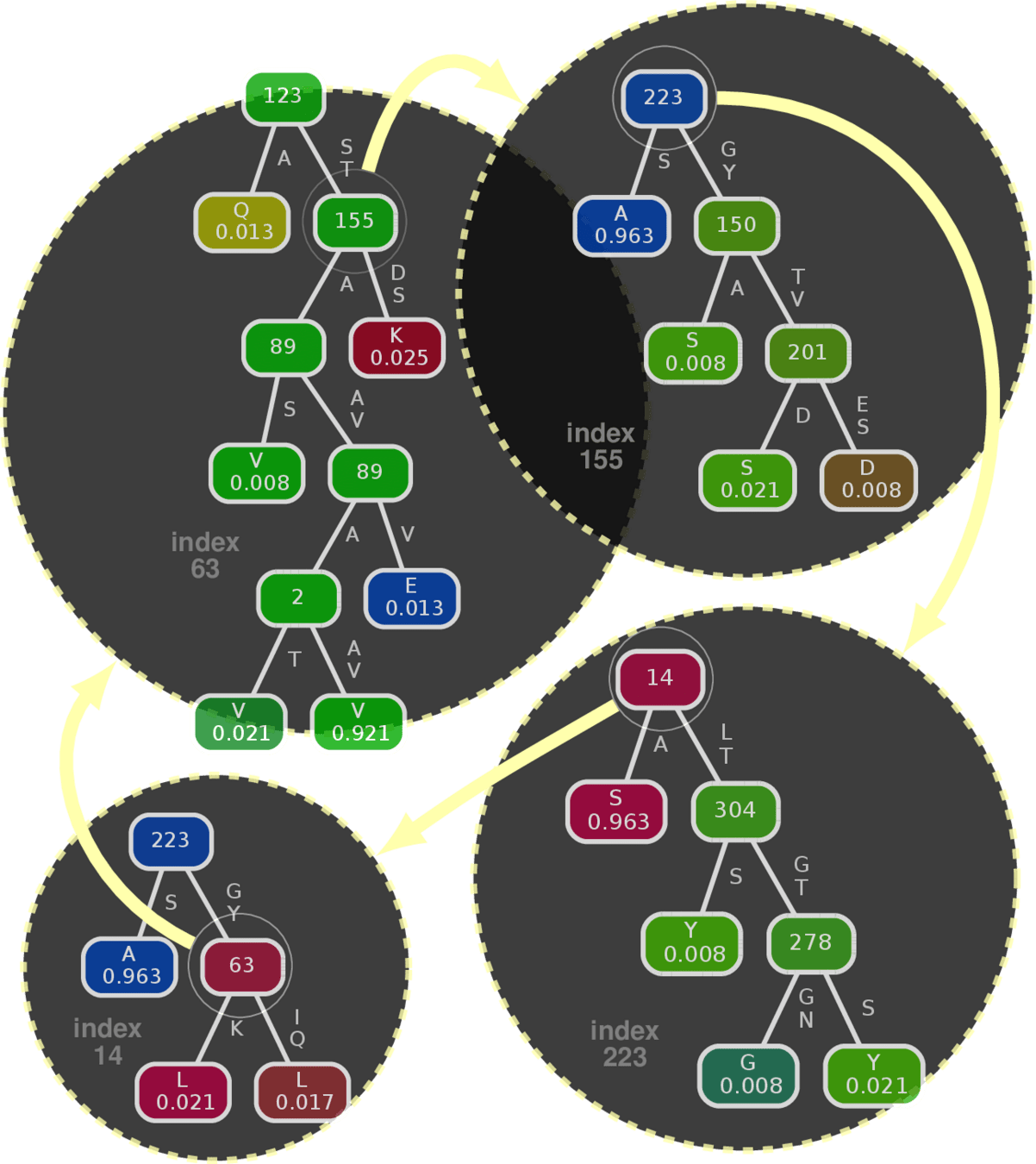
*Hothorn, Torsten, Kurt Hornik, and Achim Zeileis. "Unbiased recursive partitioning: A conditional inference framework." Journal of Computational and Graphical statistics 15, no. 3 (2006): 651-674.
emergent macro-structure
Component predictor (Conditional Inference Tree*)
Example: Influenza A HA protein
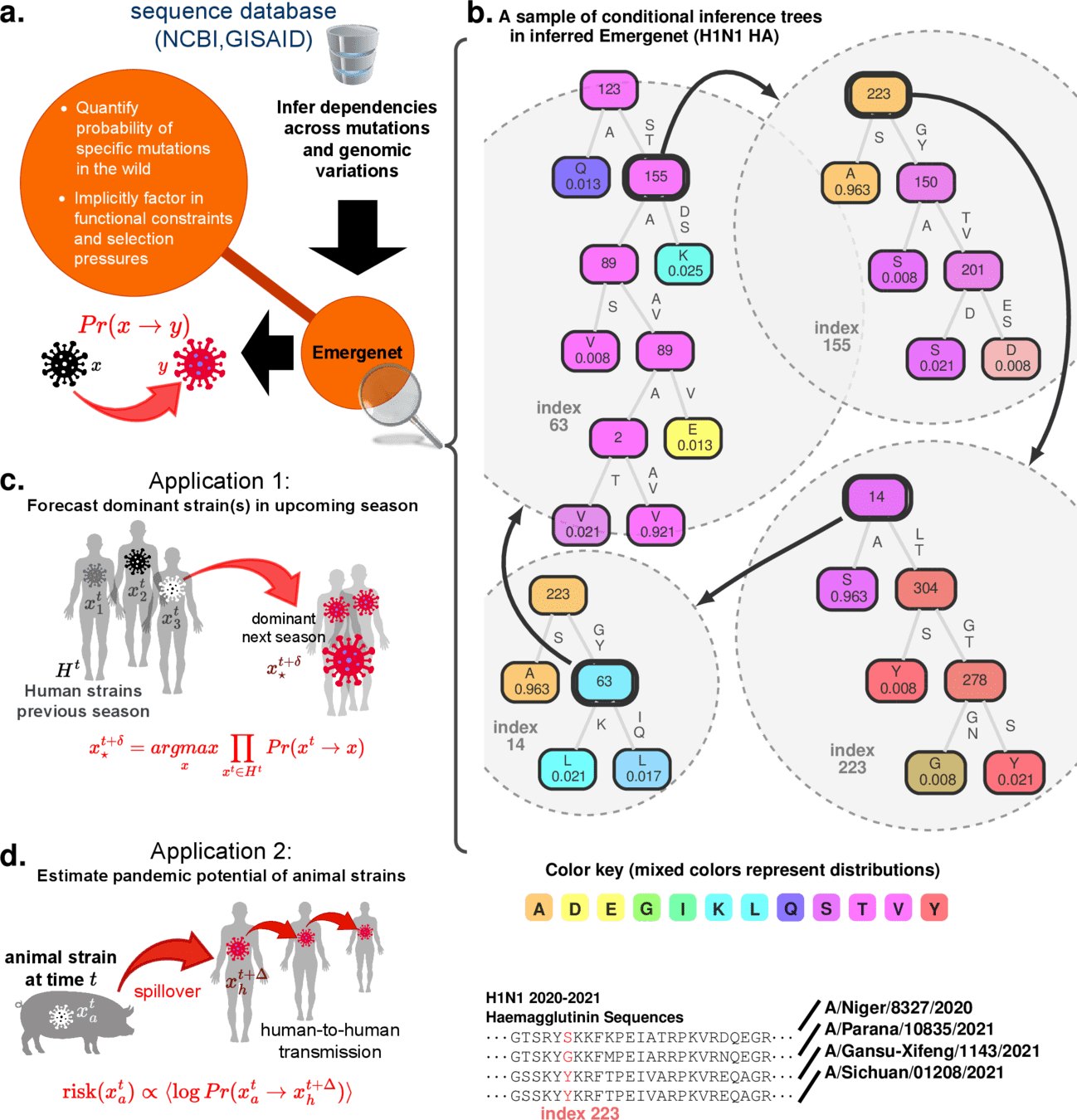
Recursive
LSM
forest
LSM Forest of Conditional Inference Trees*
Revealing Emergent Cross-talk
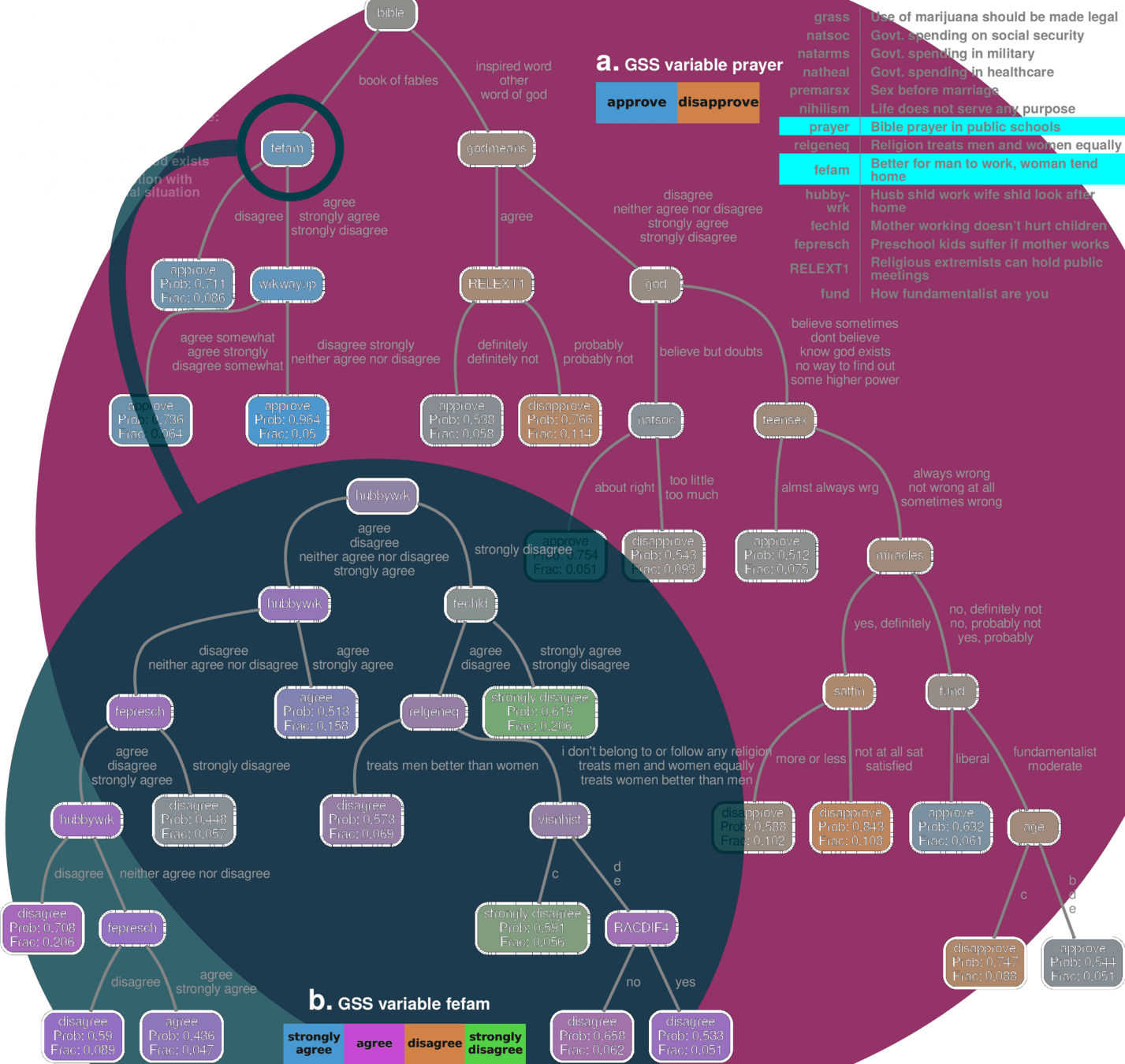
LSM Forest
Recursive LSM forest: hyperlinked nodes capturing emergent macro-structures
GSS 2018 dataset
- Set of conditional inference trees (CIT)
- Strict statistical guarantees: quantifies inference uncertainty
- Each tree models exactly one variable as a function of potentially all other variables
- Non-leaf nodes are "hyperlinked" to other trees
Large Science Models
1. How will proposer form and maintain a computationally tractable LSM tree structure given, as proposed, hundreds to thousands of observable variables?
\(\checkmark\)
GSS 2018 dataset
- Each predictor is inferred independently
- Can scale up to thousands of variables in Python implementation
- Further scale-up \(10^6 - 10^8\) needs C/C++ implementation
Full Example of Hyperlinked Trees
Large Science Models: Mathematical Framework
| reliten | gunlaw | abany | --- | grass | |
|---|---|---|---|---|---|
| Person 1 | |||||
| Person 2 | |||||
| --- | |||||
| Person m |
observables
samples
Distributions over alphabet \(\Sigma^i\)
Individual Predictor (CIT)
cross-talk
Tension between predicted and observed distribution drives change
Example
GSS topic: There should be more gun-control
\(\psi^i\)
| strongly agree | agree | neutral | disagree | strongly disagree |
Digital Twin
\(\phi\) estimates \(\psi\)
Examples: GSS, ANES, WVS, ESS, Eurobarometer, Afrobarometer, Asian Barometer etc
group
individual
estimate is always a non-empty non-degenerate distribution
missing observation
Large Science Models: Properties
LSM-Distance Metric*
where \(D_{JS}(P\vert \vert Q)\) is the Jensen-Shannon divergence.
Large Deviation Bound*
Induced Riemannian metric tensor
This bound connects ``closeness'' of samples to the odds of perturbing from one to the other, bridging geometry to dynamics
Ergodic Projection
(Sanov's Theorem, Pinkser's Inequality)
\(\psi\)
\(\psi'\)
\(\theta\)
"spatial average": average of all plausible worldviews or states
* Sizemore, Nicholas, Kaitlyn Oliphant, Ruolin Zheng, Camilia R. Martin, Erika C. Claud, and Ishanu Chattopadhyay. "A digital twin of the infant microbiome to predict neurodevelopmental deficits." Science Advances 10, no. 15 (2024): eadj0400. https://www.science.org/doi/full/10.1126/sciadv.adj0400
persistence probability
Ergodic dispersion
Central to Model Drift Quantification
Start with opinion vector with all entries missing
This is a standard Physics construct, quantifying curvature of the underlying latent geometry
Easily computable in LSM framework!
Apply \(\phi^i\)
Random variable quantifying dispersion around the spatial average of worlviews
const. scaling as \(N^2\)
Digital Twin & Fidelity of Simulation
Sample predicted distributions
perturbed state within \(\epsilon\) of \(\psi\)
| Variable | Masked | Reconstructed |
|---|---|---|
| spkcom | allowed | allowed |
| colcom | not fired | not fired |
| spkmil | allowed | allowed |
| colmil | allowed | not allowed |
| libmil | not remove | not remove |
| libhomo | not remove | not remove |
| reliten | strong | no religion |
| pray | once a day | once a day |
| bible | inspired word | word of god |
| abhlth | yes | yes |
| abpoor | no | no |
| pillok | agree | agree |
| intmil | very interested | very interested |
| abpoorw | always wrong | not wrong at all |
| godchnge | believe now, always have | believe now, always have |
| prayfreq | several times a week | several times a week |
| religcon | strong disagree | disagree |
| religint | disagree | disagree |
| Variable | Masked | Reconstructed |
|---|---|---|
| spkcom | allowed | allowed |
| colcom | not fired | not fired |
| libmil | not remove | not remove |
| libhomo | not remove | not remove |
| gunlaw | favor | favor |
| reliten | no religion | no religion |
| prayer | approve | approve |
| bible | book of fables | inspired word |
| abnomore | yes | yes |
| abhlth | yes | yes |
| abpoor | yes | yes |
| abany | yes | yes |
| owngun | no | no |
| intmil | moderately interested | moderately interested |
| abpoorw | not wrong at all | not wrong at all |
| godchnge | believe now, didn't used to | believe now, always have |
| prayfreq | several times a week | several times a week |
2018 GSS individual samples
Digital Twin
-Neighborhood of state \(\psi\)
Definition
Sample neighborhood to impute missing data
}
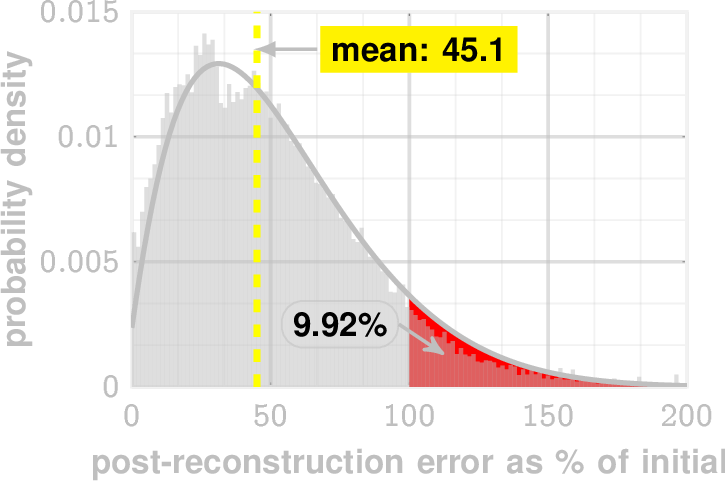
2018 GSS out-of-sample reconstruction
post-reconstruction error ratio (%)
LSM sampling: sampling the \(\epsilon\)-neighborhood of a state or worldview allows reconstruction of censored opinions
examples
Predictive ability of LSM quantified as ability to reconstruct censored out-of-sample opinions**
Null state (all missing observations)
Valid perturbations/ simulations
LSM sampling allows simulating opinion perturbations
Both Individuals and groups maybe modeled as digital twins\(\dag\)
Global Emergent Structure via Clusters & Poles
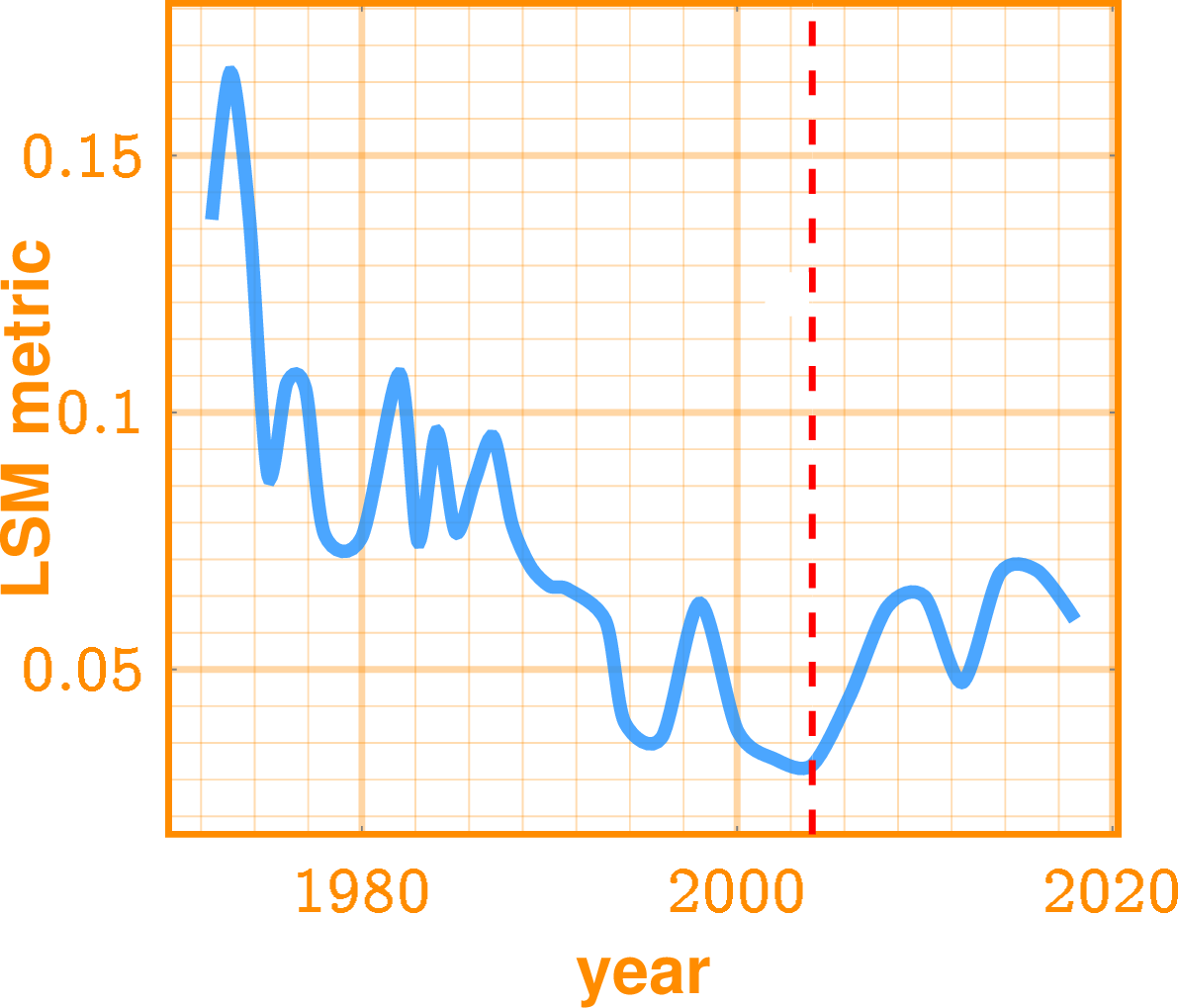
2018 GSS
Polar separation over time
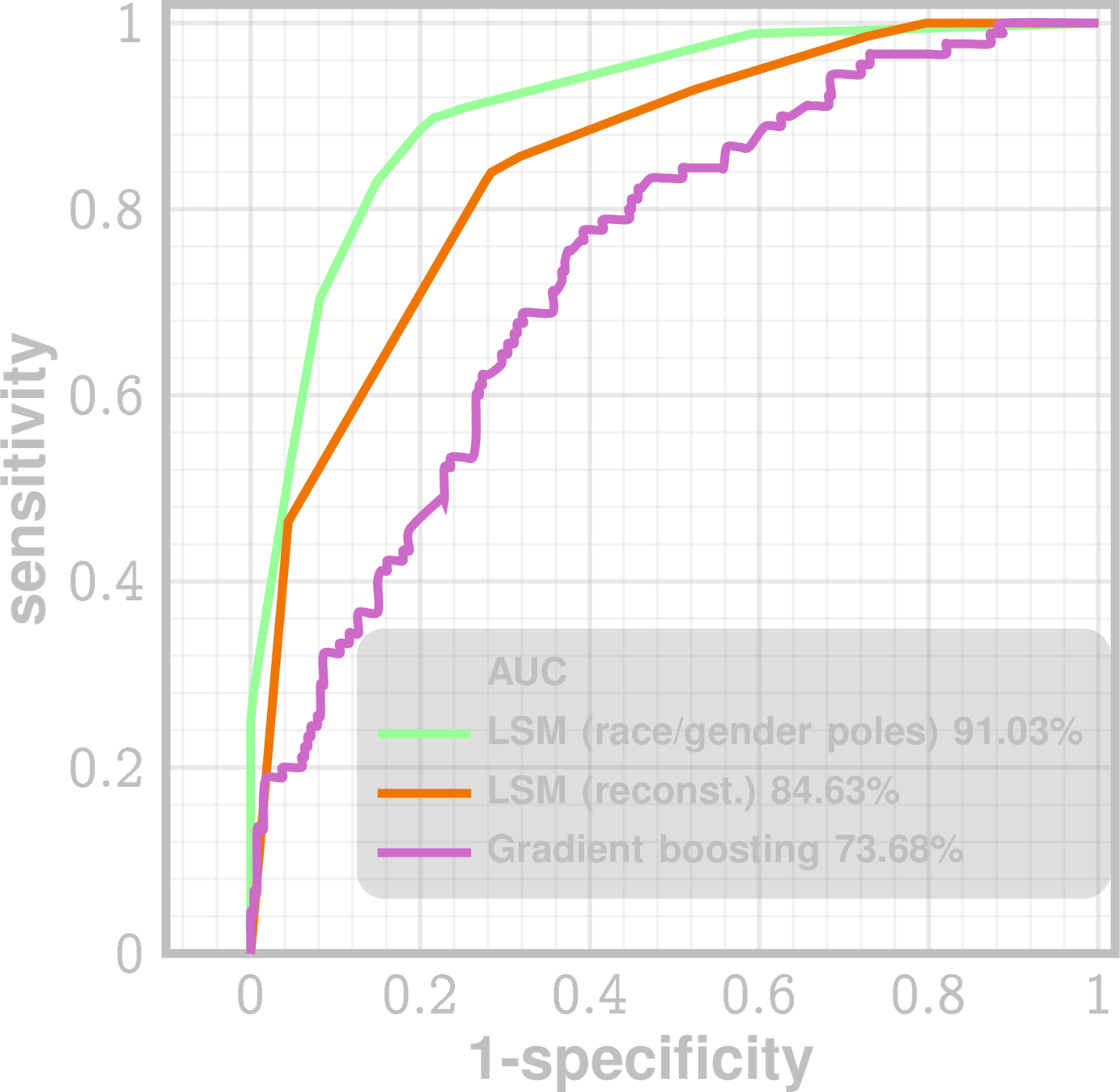
2016 Presidential Election Vote Prediction

2004
| abany | no | yes |
| abdefctw | always wrong | not wrong at all |
| abdefect | no | yes |
| abhlth | no | yes |
| abnomore | no | yes |
| abpoor | no | yes |
| abpoorw | always wrong | not wrong at all |
| abrape | no | yes |
| absingle | no | yes |
| bible | inspired word | book of fables |
| colcom | fired | not fired |
| colmil | not fired | not allowed |
| comfort | strongly agree | strongly disagree |
| conlabor | hardly any | a great deal |
| godchnge | believe now, always have | don't believe now, never have |
| grass | not legal | legal |
| gunlaw | oppose | favor |
| intmil | very interested | not at all interested |
| libcom | remove | not remove |
| libmil | not remove | remove |
| maboygrl | true | false |
| owngun | yes | no |
| pillok | agree | strongly agree |
| pilloky | strongly disagree | strongly agree |
| polabuse | no | yes |
| pray | several times a day | never |
| prayer | disapprove | approve |
| prayfreq | several times a day | never |
| religcon | strongly disagree | strongly agree |
| religint | strongly disagree | strongly agree |
| reliten | strong | no religion |
| rowngun | yes | no |
| shotgun | yes | no |
| spkcom | not allowed | allowed |
| spkmil | allowed | not allowed |
| taxrich | about right | much too low |
conservative pole
liberal pole
Clustering LSM distance \(\theta(x,y)\) between out-of-sample individuals
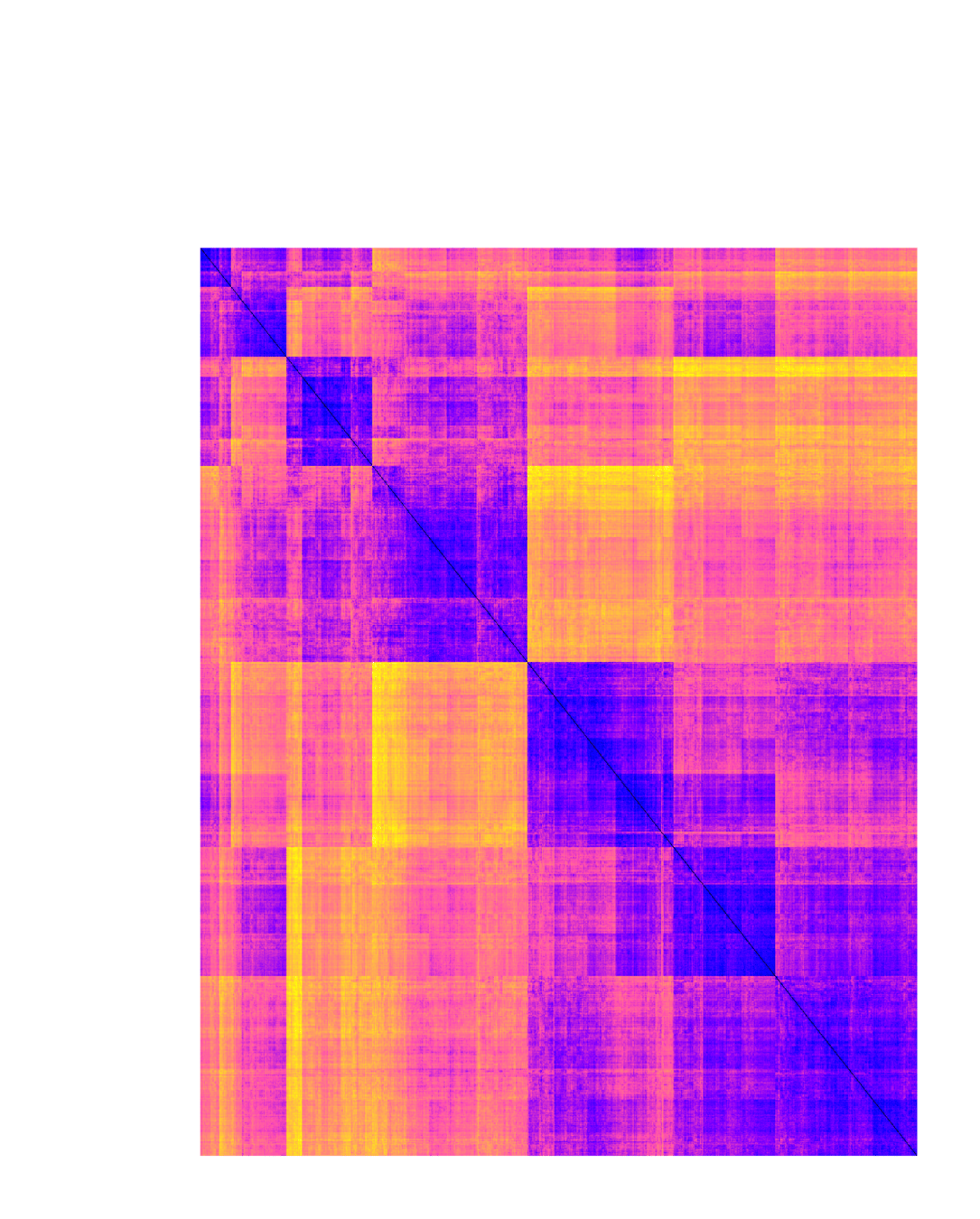
conservative
liberal
poles:
partial states aligning with extreme opposing worldviews
- Compare across time and different GSS surveys
- Derived features for individuals (ideology index)
Predict 2016 votes using ideology index
Emergent global structure
Reflexivity and State Collapse on Observation
Emergent Equations of Motion
Define Lagrangian*
Via the Euler-Lagrange Equations\(^\dag\):
Over-damped Gradient flow Equation*
where \(-g^{km}\) is the inverse metric tensor
kinetic energy
state collapse
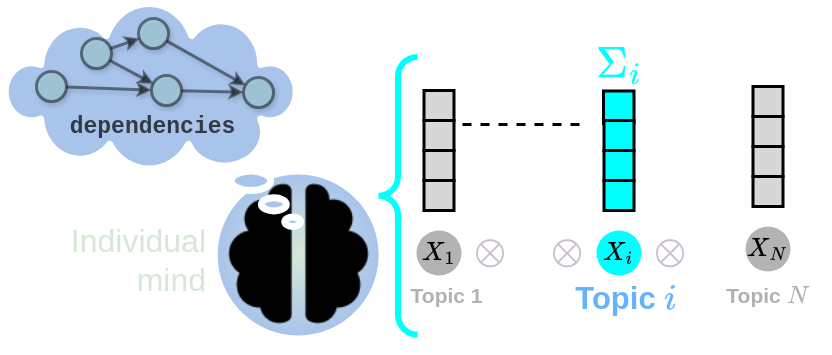
strongly agree
agree
neutral
disagree
strongly disagree
strongly agree
agree
neutral
disagree
strongly disagree
Query/
Observation
\(X_i\)
Non-local Influence propagation on measurement/observation (QM-like)

potential energy
* Einstein notation used
Goldstein, Herbert, et al. Classical Mechanics. 3rd ed., Pearson, 2002.
\(^\dag\)
Principle of stationary action
Dynamics
Local potential field eqn
Local Potential Fields
Stable
(captured by local extrema)
Free to move locally towards extrema
Why propaganda works so well
* “Exposure to opposing views on social media can increase political polarization”
by Christopher A. Bail et al., published in PNAS in September 2018 (Vol. 115, No. 37, pp. 9216–9221; DOI: 10.1073/pnas.1804840115)
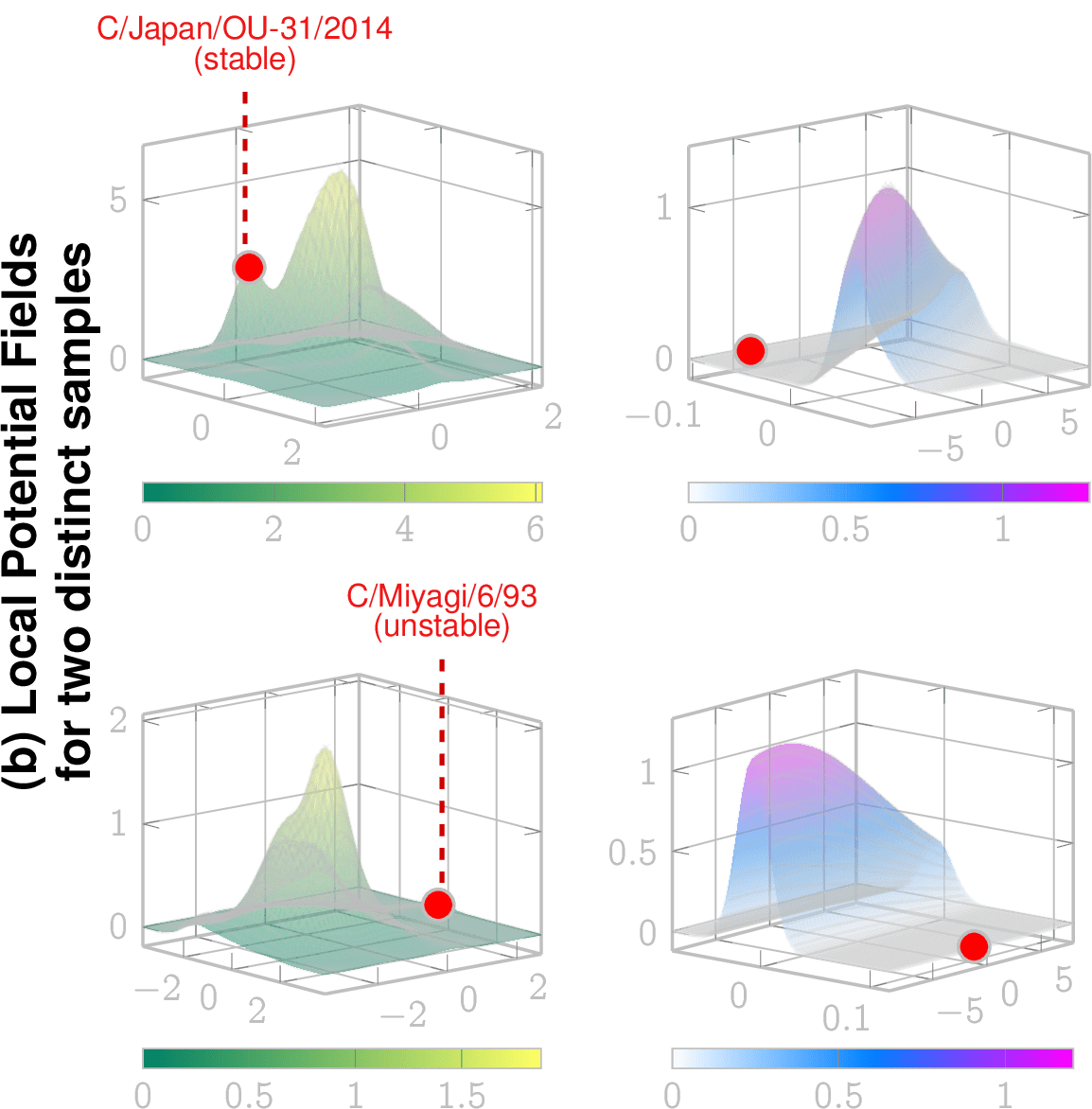
GSS 2018 individuals and neighborhoods
Influenza C : strains and their neighborhoods
Even random perturbations will tend to move individuals towards local extrema increasing polarization
*
- Polarization is "easy", can occur via random perturbations (falling into the local well)
Hypotheses
Observation: This lineage (Mississippi lineage) is now extinct since 2022/23
stable lineage
Implications on Social Theory
The LSM tells the latent opinion "space-time" how to curve, the curved "space-time" tells opinions how to change.
Local potential fields can be computed given the LSM and dynamical considerations, which reveal future evolution
- De-polarization is "hard", needs specific communication (climbing up from the well)
Data Sufficiency via Conservation of Complexity
The No-cheating Thorem: Generative models cannot cheat on complexity
Kolmogorov Complexity
Optimal Generative Model
compressed data representation
compressed model representation
Theorem
Conservation Law arising from the continuous symmetry of typicality*
Saturation relation:
Data Sufficiency Statistic \(\mu_0\)
We need LSM-sampling to calculate this
*Noether's Theorem
For every continuous symmetry of a physical system, there exists a corresponding conserved quantity
How much more data do we need?
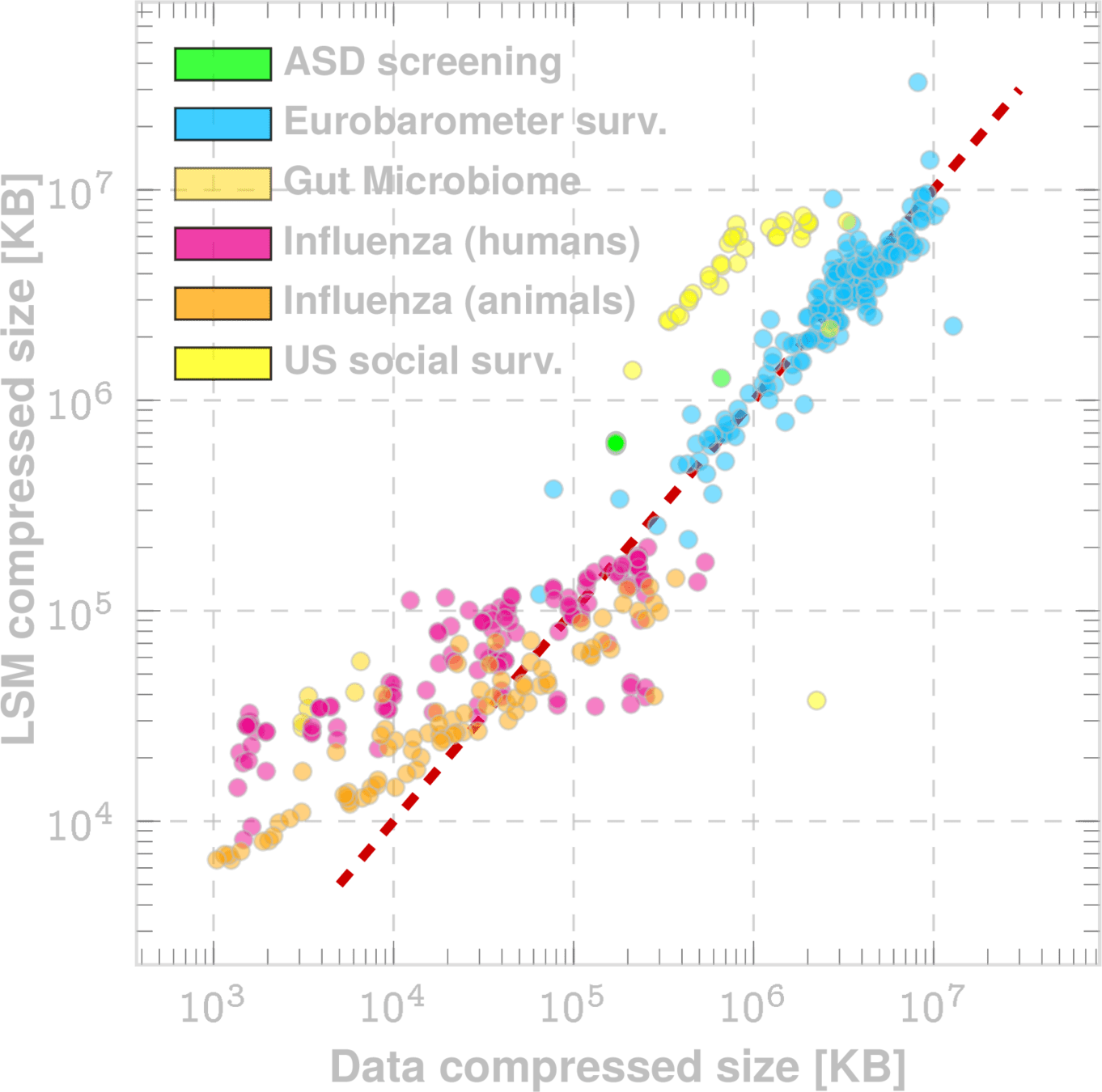
Data saturation
Data deficient
Needed
Current
Empirical Validation
Model Drift Quantification
Ergodic dispersion
Z-value of dispersion
Do new samples (survey respondents) still conform to the model?
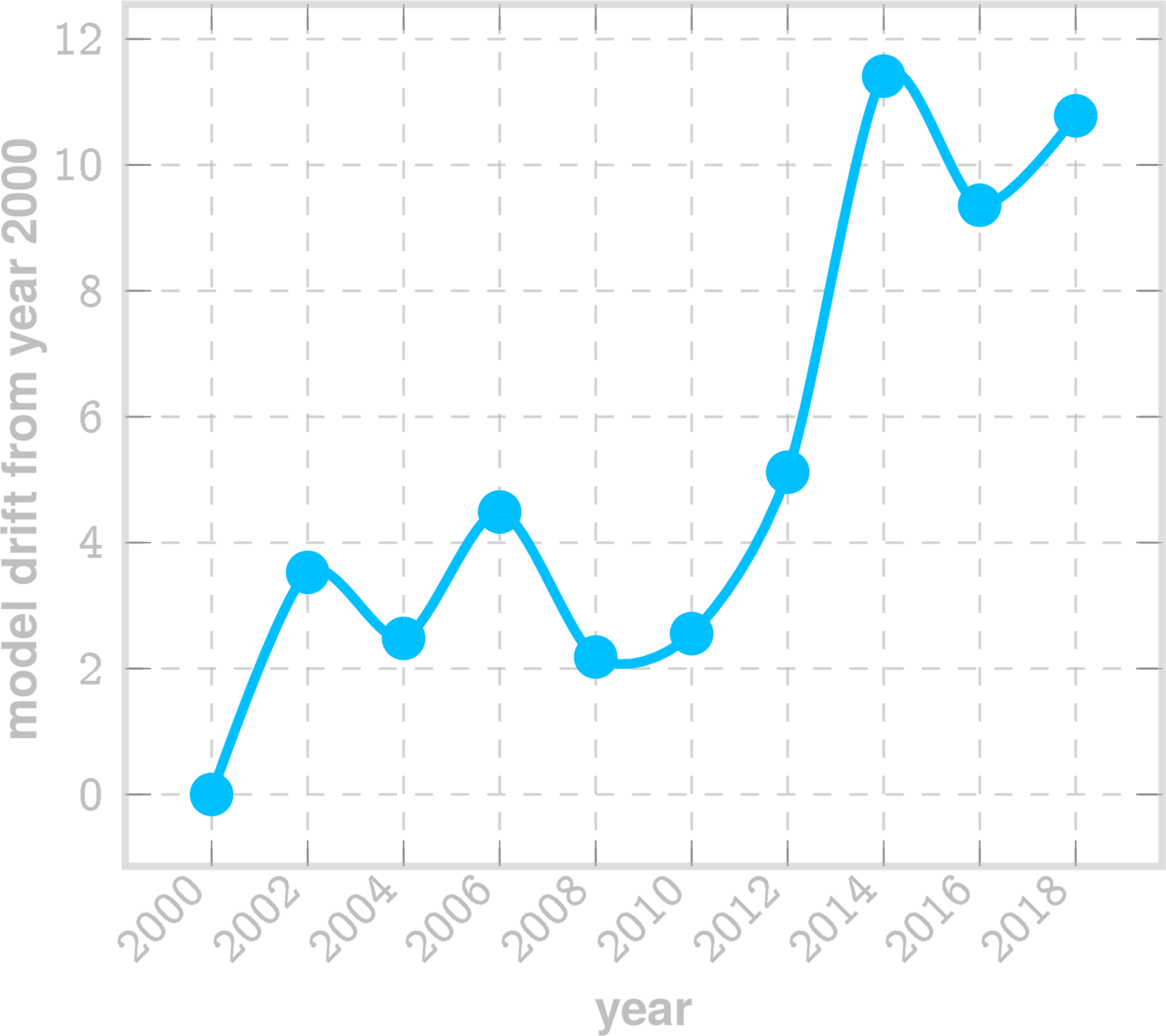
GSS Model drift
ergodic projection (all missing values)
A random belief state (with possibly missing entries)
random variable
normal variate
Model drift stochastic process (\(\zeta\))
assess if \(\zeta\) is stationary: if not then new samples are not conforming to model
Example for GSS LSM inferred for year 2000
Large Science Models & Ergodicity
\(\checkmark\) 4. Address whether your approach makes assumptions regarding ergodicity, and if so, how these assumptions affect the model's applicability to non-ergodic systems.
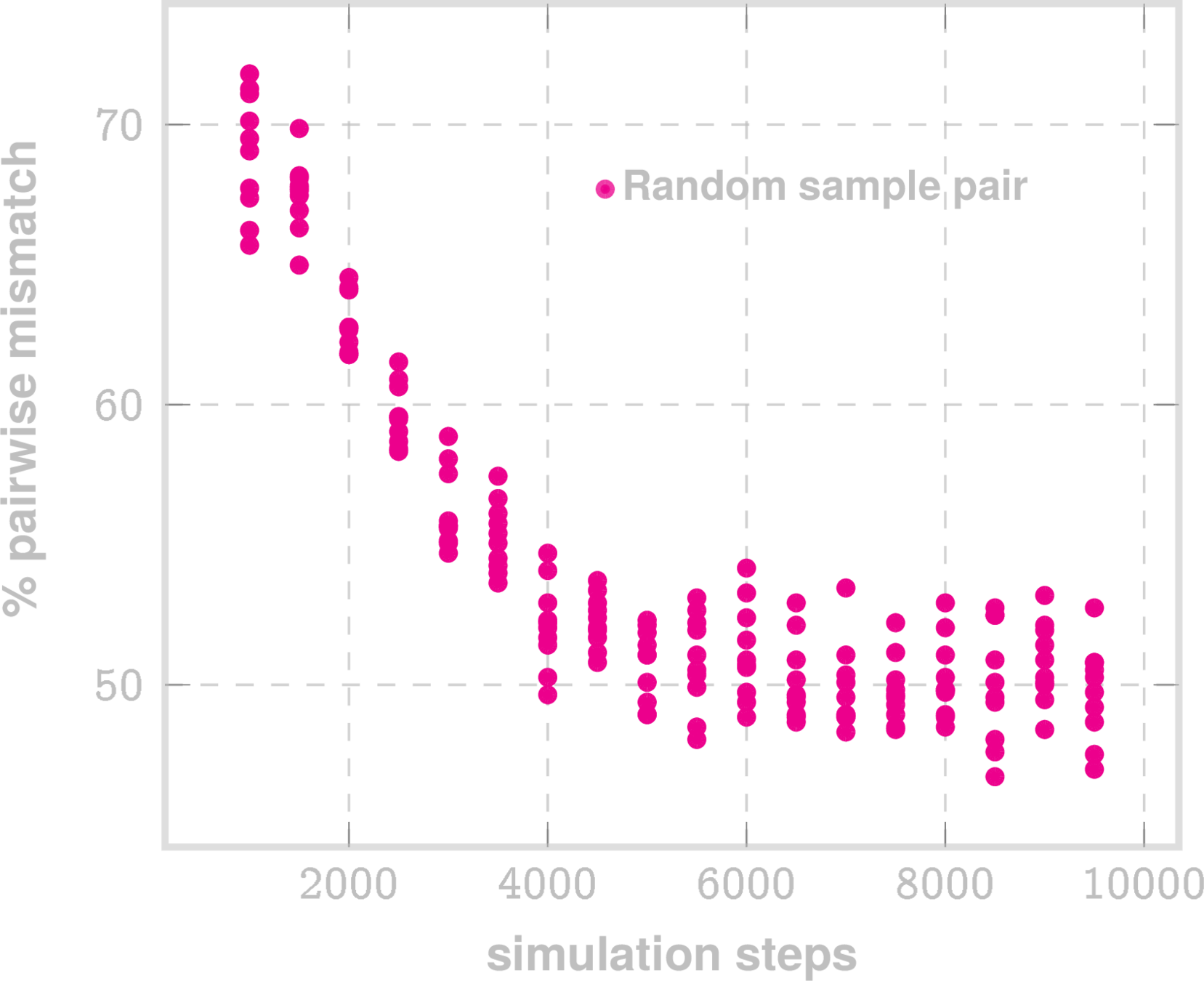
No Convergence
(~50% belief mismatch between pairs)
2018 GSS survey belief vectors simulated via LSM sampling
- No ergodicity assumption: LSMs are built for non-ergodic systems
- Sampling and simuation "remembers" the start point (No convergence), demonstrating non-ergodic learned structure
- Local potential fields vary across the space
- Potential wells may arise, driven by the dynamics at hand, not via assumptions
- "change" is driven by non-equilibrium (dissonance)
Embedded Social Theories in LSM
When applied to Social Modeling and Opinion Dynamics
-
Belief about topic iii is expected to align with beliefs about other topics \(\displaystyle\psi^{-i}\).
Deviations are exponentially improbable \(\Rightarrow \) people/groups seek internal coherence. -
Theory Link:
-
Cognitive consistency theory – Abelson et al. (1968)
-
Constraint satisfaction in beliefs – Read & Marcus-Newhall (1993)
-
-
Beliefs evolve to minimize tension between actual state and “expected” state.
Reflexive gradient flow — system reduces internal contradiction. -
Theory Link:
-
Cognitive Dissonance Theory – Festinger (1957)
-
Homeostatic belief adjustment – Gawronski & Strack (2004)
-
-
Observing a belief changes it and affects all conditionals.
Direct encoding of feedback loops central to human systems. -
Theory Link:
-
Reflexivity in social systems – Giddens (1984), Soros (1994)
-
Theory of mind / mutual modeling – Premack & Woodruff (1978)
-
Validation of Social Theory Questions:
- Perception changes reality, which changes perception
- The Constitution of Society
- The Alchemy of Finance
- Does a chimpanzee have a theory of mind?
- Our system “wants” to reach a low-energy (low-dissonance) state — a direct computational analog of Festinger’s theory.
- People strive to align beliefs and attitudes across related domains. Inconsistencies create cognitive discomfort, prompting adjustments across belief clusters to restore harmony.
| Exploratory: Belief systems react measurably to exogenous events and shocks |
Exploratory: Cross-dependencies between beliefs have observable effects on societal resilience.
Is Polarization an Inevitable Attractor?
Social Identity Theory vs. Belief Proximity
Large Science Models: Broader Applications
A General Framework for modeling Complex Systems
Genomic database: Missing heritability problem
Personalized Clinical Digital Twin, Virtual Patients
Any structured interview, PTSD fabrication
Assess sysmptom data and co-pathologies
Predict future mutations; which animal strain is closest to jumping to humans
Mental health diagnosis
Microbiome Analysis**
Algorithmic lie detector
Viral emergence
Teomims
Opinion Dynamics
Darkome
Generative model of complex microbial ecosystems, and their impact on health and disease
Data requirements
- Tabular data
- Potentially large number of features/covariates (\(10^2 - 10^8 \))
- Sufficient number of samples (\(10^3 - 10^6\))
- Small number of longitudinal samples (currently, \( < 100\))
| Limitation | Mitigation / Response |
|---|---|
| Conventional time series is currently out-of-scope | Focus on cross-sectional interdependencies and belief geometry; time handled via drift |
| LSMs model statistical interdependence, not causal mechanisms | Use perturbation-based simulations to infer plausible influence pathways |
| Limited by observed belief variables | Integrate multiple surveys; use latent proxies and test sensitivity of digital twins |
| Social theory connections and interpretability may be challenging | Anchor dynamics with theory-driven constructs (e.g., ToM, cognitive dissonance) |
LSMs for complex systems
**preliminary study published (https://www.science.org/doi/10.1126/sciadv.adj0400)